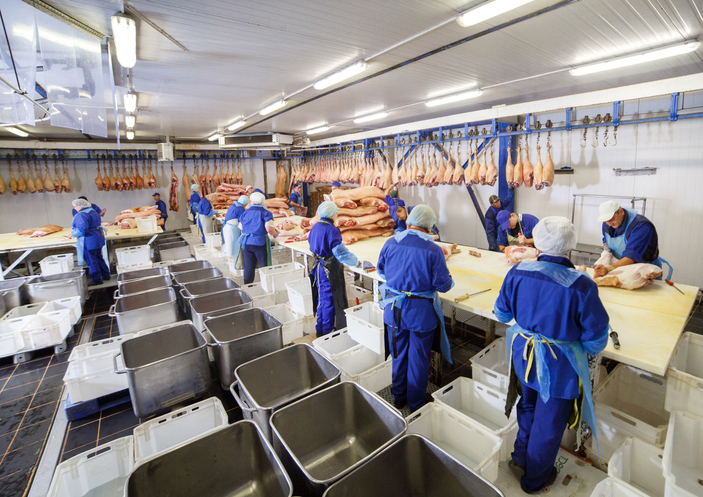During the early weeks of 2020, coronavirus seemed like a distant threat. When the virus finally hit the United States, it struck hard in urban areas, most notably New York City, where the notion of social distancing seemed almost laughable. For the one in five Americans who live in small towns and rural communities, where distance is a part of life, the virus still seemed like a problem for someone else, somewhere else.
Until it wasn’t.
In early spring, a series of outbreaks at meatpacking plants roared across Siouxland — the geographic region at the intersection of South Dakota, Iowa, Minnesota, and Nebraska and home to the Big Sioux River basin. The long hours and crowded working conditions created the first superspreader event in rural communities.
By the end of May, rural counties with meatpacking plants had an infection rate five times higher than the rest of rural America. As of mid-September, nearly five hundred meat processing plants had experienced outbreaks, more than 41,000 workers had been infected, and at least two hundred had died.
The superspreading conditions of meatpacking plants are not just a threat to the plant workers but their entire communities. Hall County, Georgia — home to Gainesville, the “poultry capital of the world,” and more than a dozen meatpacking plants — has seen more than 7,000 cases since March. The infection rate in the county is approximately forty percent higher than in the Atlanta metro area.
Today, due to the negligent response of both the federal government and the meatpacking industry, COVID-19 is anything but a distant threat to rural Americans. Rural communities account for a disproportionate number of coronavirus cases and deaths. Throughout most of the summer, rural counties accounted for 17.3 percent of new COVID cases and 18.9 percent of COVID-related deaths, despite housing only 14 percent of the U.S. population.
Immigrant Communities Lead the Response in Rural America
In early March, immigrant rights organizer Alejandro Murguia-Ortiz was door knocking for Bernie Sanders in Minneapolis. Coronavirus loomed like an ominous cloud, and the meatpacking plant where his parents worked still had not enacted significant safety measures. His parents were close to retirement and reluctant to do or say anything that could jeopardize their employment. Like the many immigrants and refugees who make up a sizable portion of meatpacking workers, they faced language, literacy, and cultural barriers that can make it difficult to navigate the workplace at the best of times.
But immigrant workers were especially at risk for contracting COVID-19 due to poor working conditions, low pay, immigration status, and lack of benefits. Additionally, many workers reside in crowded multi-family, multi-generational, or congregate homes, adding another layer of vulnerability.
Soon, Murguia-Ortiz’s father became infected at work; despite their best efforts to live on opposite sides of their shared trailer, his mother, sister, and brother-in-law all got sick. Eventually, at least ten people in his extended family became infected; one or two required hospitalization.
On April 21, Murguia-Ortiz started a Facebook group with over nine hundred members to organize meatpacking workers across the region. Just one week later, the group’s mission to ensure worker safety over corporate profit became more imperative, as President Trump ordered meatpacking plants to stay open without any clear rules or safety regulations.
The group built a coalition with local immigrant rights and Latinx organizations and advocated in the media for safety measures in the Waterloo Tyson plant, such as plexiglass barriers between stations, masks and shields for workers, and infrared temperature scans to detect fevers among workers. The plant eventually adopted the group’s recommendations.
The group also functions as a place where workers and loved ones can work together, answering each other’s questions and navigating changing rules and regulations in the workplace to ensure no one is taken advantage of — and to hold employers accountable.
After the group’s inception, grassroots organizing organically emerged in communities across the region. In Nebraska, about fifty workers at a Smithfield Foods pork plant organized a walk off to protest the stress many were feeling as they worked “elbow to elbow, shoulder to shoulder,” cutting and packaging meat. In response, meatpacking plants throughout the country have begun adopting similar safety measures.
While it’s certainly better than nothing, given the damage already done, it sometimes feels too little too late. OSHA is now fining companies for pandemic violations, but Smithfield — whom the Centers for Disease Control found to be shockingly negligent in its handling of their outbreak — was only fined $13,494, more like a reluctant formality than a true win for workers.
Organizers with Poder NC in North Carolina also used a Facebook group to advocate for vulnerable agriculture workers. Iliana Santillán, the director of People Power, told me how they fought to ensure “rural areas had food at their pantries, media attention was given to unsanitary work conditions, testing centers who were charging folks for a test were reported, parents were able to ask questions about online school.” The group also created the website Miparati.com to help rural families financially and began leveraging networks to register people to vote through votemosnc.com.
It’s an uphill battle. And there is more than one hill.
The Next Hill
It’s hard to believe that it’s only been six months since the meatpacking outbreaks swept across so much of rural America. Over the last few weeks, COVID-19 has once again spread at a rapid pace, especially in the Upper Midwest, where high rates of new infections have appeared far beyond meat packing communities.
According to a Daily Yonder analysis, more than ninety percent of rural counties in Wisconsin, South Dakota, and North Dakota have troublesome levels of new infections; 66 of Iowa’s 78 rural counties (or 85 percent) show high rates of infection. The rate of new infections and deaths is now worse in rural counties than in urban ones.
The rural COVID-19 outbreaks thrive in states where lawmakers have followed President Trump’s lead on statewide shutdowns and mask mandates. The Governor of South Dakota even went so far as to host an annual motorcycle rally attracting over 400,000 tourists; cases in the region have been climbing at an alarming rate ever since.
At the same time, in-person classes began in the college towns scattered all over the Midwest. Online classes don’t pay the bills, so these small town colleges are staying the (open) course. The service industries in the surrounding communities — often staffed by immigrants and people of color — also stay open.
“We’ve been trying to raise that alarm,” Murguia-Ortiz says. “What we saw in these plants is what we’re going to see in these schools.”
Organizing in Response to Crisis
Many rural communities in red states lack the institutional civic infrastructure, such as unions and community groups, so desperately needed in times of crisis. For these rural communities, especially those with vulnerable populations, Murguia-Ortiz offers his advice: do not wait for the government or institutional leadership — they will prioritize the message that “things are under control” over reality.
Today, an informal network of community leaders, public health professionals and educators has emerged in response to the rural COVID-19 outbreaks. Many learned from Murguia-Ortiz, Santillán, and other young leaders from meatpacking communities in the national RuralOrganizing.org network that we can’t wait for government action.
They’ve started local, grassroots public awareness campaigns to educate community members about the dangers of COVID and created an underground network of healthcare providers who are actively tracking regional staffed ICU bed capacity, which is not currently tracked by the state of South Dakota. They’ve started online petitions demanding mask mandates in South Dakota and Iowa and even successfully advocated for the first citywide mask mandate in the region.
These grassroots leaders are reinventing rural organizing — and have developed a more robust crisis response network than what’s currently being provided through their own state governments. None of this would have been possible without the initial leadership of organizers like Murguia-Ortiz, Santillán, and so many others in rural immigrant communities who took a stand last spring.
It’s like Murguia-Ortiz told me earlier this summer, “If you’re able to tackle and solve the issues of the most vulnerable, you’re going to be able to solve everyone else’s issues. You’re going to have the tools to solve the simpler issues.”
Read the entire issue on Organizing in Rural America.

